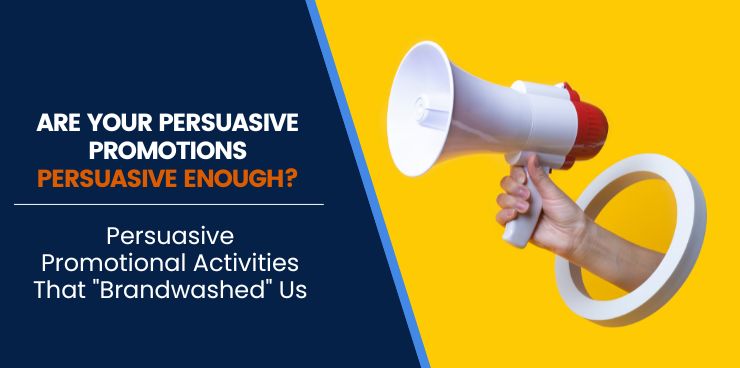With the rise of technology, consumers have acquired a more advanced level of smarts in their everyday buying decisions. Instead of their eyes glistening in desire when seeing a new product promotion on TV, ads are met with skepticism.
There’s just one problem: as consumers become smart, companies become smarter.
Persuasive promotion and marketing have now become more sophisticated than ever before.
When ads put us on edge and force us to buy a solution, let our response be: “they employed really effective persuasive promotion.” However, is the ad really that persuasive to blow a thousand bucks on without much thought? Or are they infusing their ads with voodoo magic that makes them hard to say “no” to?
Well, neither. There is a correct answer, though.
Enter: Brandwashed by Martin Lindstrom!
This eye-opening book reveals the trade secrets that companies do to make their persuasive promotion, even more persuasive. Through Lindstrom’s teachings, you can spruce up your marketing and give people a solution where “no” is not an option. In this article, I will teach you the key points in his doctrine.
Interested? Keep reading.
Martin Lindstrom’s Brandwashed
Before anything else, who is this Martin Lindstrom and what makes his writings reliable?
Martin Lindstrom is the primary thought leader when it comes to branding and culture. With decades of experience, he has worked with various household brands to make them the colossus they are today.
Marketing and advertising are no different from branding. They are essentially the stories you sell people. In other words, when they buy your story, they’re more likely to buy your product.
His book “Brandwashed: Tricks Companies Use to Manipulate Our Minds and Persuade Us to Buy” outlines this perfectly.
This book will demonstrate how companies design their persuasive promotion to exploit the psychological weak spots of consumers. In many cases, customers will believe they are making a rational choice with their buying decisions. However, underneath the research and supposed justification, they are just brandwashed to choose one solution over another.
Lindstrom divulged the biggest techniques that successful companies used in their marketing, so you can use them yourself. Ready to find out what those are? Explore the rabbit hole below.
 “The younger we are when we start using a brand or product, the more likely we are to keep using it for years to come.” — Chapter 1
“The younger we are when we start using a brand or product, the more likely we are to keep using it for years to come.” — Chapter 1
Did you know that people become targets of persuasive promotion starting from the womb?
Even before you were born, you were already in the demographics targeted by companies for advertising.
Allow me to explain.
A fetus can perceive sounds coming from its external environment. Since fetuses are extensions of a mother’s body, whatever a mother hears, the baby does too. When a mother likes a tune from an ad jingle, the baby will also share the positive emotions she’s feeling. Hearing or listening to the same tunes later in life will trigger the same feelings they had in the womb.
Moreover, kids believe that some products can be tools to forge meaningful relationships with others. For example, a kid that received LEGOs and made friends through them will always have a fondness for the toys.
Finally, children believe everything in their family is normative. That explains why most still buy the same milk and orange juice brands they had since childhood. They associate these brands with the warm affection of a loving family and the nostalgia of a comfortable home.
“Marketers are amazingly adept at identifying fear, activating, amplifying and then preying on it in ways that hit us at the deepest subconscious level.” — Chapter 2
When people fear for their lives, they will do everything in their power to escape the imminent threat. More often than not, this leads people to act out of rationality.
Most buyer archetypes can be classified into two categories: surviving and thriving modes. Both have their respective motivations for the actions they commit. Thrivers are generally motivated by their desire for identity, purpose and adventure. Conversely, survivors tend to be more transactional by nature and are principally motivated by their inherent nature – survival.
That said, people in survival mode are often the victims of fear-based advertising. The wirings in their brains are geared to act quickly in the face of threat. Although these buyer archetypes apply in the context of money, they could be appropriate for other situations too.
For example, let’s look at the previous covid-19 pandemic. Companies like Lifebuoy and other germicidal brands used fear to incite people’s need to protect themselves. Of course, anyone that’s sensible would know that viruses are not germs, and so germicidal products won’t kill covid.
Fear is an effective tool, but it should be used sparingly because buying from negative resonance is never advisable. Fortunately, that’s not who we are. Wizard of Sales® can help you craft the perfect advertisement that strikes a ethical dose of fear in your market. Book a call.
 “In the future, the convergence between gaming and buying, especially online, will only continue to intensify.” — Chapter 3
“In the future, the convergence between gaming and buying, especially online, will only continue to intensify.” — Chapter 3
Do you know why gamers can’t get enough of playing? It’s addictive.
There’s a certain level of satisfaction people get when they upgrade their levels or get exclusive rewards for playing. This same principle applies to marketing and advertising. When you infuse gamification into your persuasive promotion, you increase the likelihood of getting addicted.
When shopping addicts buy, their brains get flooded with a hormone called dopamine that gets them high and feel gratified. This high drops eventually, but addicts will go on a shopping binge to regain that feeling of rush.
In your business, you could offer exclusive rewards or deals for loyalty that gets your market hooked. For example, residential home services could sell club memberships that gives members exclusive perks and benefits.
“Today’s marketers have their ways of tapping into our most basic and primal human desires while making money in the process.” — Chapter 4
Sex in advertising no longer sells as much as it did 20 years ago. In one of Lindstrom’s books, he explained that sexually suggestive content can be repulsive to women and distracting to men. While sex is the one of the most popular primal need used by advertisers, not everyone still uses it as leverage. At least not explicitly.
For example, when scantily clad models subtly pervade an ad, mirror neurons of audiences get activated. What this means is that viewers tend to imagine themselves as the person being presented.
Guys may imagine themselves to be as hunky and desirable as Isaiah Mustafa if they wear Old Spice deodorant. Ladies, on the other hand, may feel sexy and free using the same makeup Lady Gaga uses. The idea of creating desirability is a powerful tool in persuasive promotion.
“Peer pressure may sometimes work in backward ways, but the psychology behind it—the desire for acceptance—remains the same.” — Chapter 5
No man is an island, everyone is a social being. With being naturally social comes the inherent need to fit in and belong to the tribe. This is called peer pressure. You feel uncomfortable when left out but experience satisfaction when doing what everyone does.
This also means wanting to own what other people have.
Relational buyers, a.k.a. people with more money, are often motivated by their desire for personal identity. They want to be known and revered as a special identity and seen as a part of their social hierarchy. With that in mind, people within this category will do whatever it takes to belong.
For example, they are likely to buy competent convenience instead of more affordable solutions. This is especially true when everyone in their community does the same. When you become the brand that satisfies this desire, you become their choice provider.
Everyone wants to belong, if your persuasive promotion tells them that you can satisfy that desire, you get the sale.
“Nostalgia marketing is a perennial and wildly successful. — strategy by which advertisers resurrect the sights, sounds, and feel of a previous decade to sell us a brand or product of today.” — Chapter 6
Nostalgia is an effective weapon because it reminds us of the good old days, never the suffering. When we recall something nostalgic, our hearts automatically soften and our minds ease up.
Let me put it in perspective.
If mothers only remember the pain of childbearing and birth, they will likely refuse another by all means. However, all pain fades when they hold their child for the first time. The same goes for persuasive promotion.
Adding a drizzle of nostalgia to your advertising makes people keener to listen to what you have to say.
“Making us feel like celebrities or royalty (or some unholy combination of the two) has long been a marketing strategy of choice within the travel, hospitality, banking, and gaming industries.” — Chapter 7
Everyone wants to fit in, yes, but equally, everybody also wants to stand out. You want to fit into a particular context, but elevating oneself above the fold gives an exuberance like no other. Businesses that utilize this celebrity or royalty-like power in their persuasive promotion understand people’s narcissistic nature.
For example, selling club memberships that give people 24/7 support, priority services, exclusive perks and benefits are advertising bangers.
Why?
Everyone wants to feel special, one way or another. If your products give them that special treatment, you win.
“Whether the brand’s promise is health, happiness, or enlightenment– Hope may be an illusion, but we believe in it– and we’re willing to spend our hard-earned money for it— all the same.” — Chapter 8
In many ways, hope and advertising are one and the same thing. They are both a promise of what is to come. Of course, ads can be deceitful and bring people false hope, but the thing is, consumers still buy into them.
Hope is anchored on the fact that maybe, just maybe, the solution may work on the consumers. How many people buy dietary supplements in hopes to lose weight but don’t actually trim their food intake and exercise? Too many to mention.
They leave behind all sense of logic and rationality for hope.
However, there’s a caveat. When you sell hope and it disappoints, you also lose your reputation in the process. Therefore, only sell the hope you can confidently meet.
“So yes, while companies and marketers have all kinds of sneaky ways of tricking us into buying their products, at the end of the day we’re not just being brandwashed by companies— the fact is, we’re also being brandwashed (and sometimes in a good way) by one another.” — Chapter 9
This principle goes back to the fact that we are all social beings. Peer pressure hits differently especially if we’re the only ones left out in a particular trend. But it’s not only others that brandwash one another, people are also susceptible to brandwashing themselves.
Always keep in mind that all buying decisions stem from the part of the brain that exclusively feels. There’s no logic nor words that work on it. Whether that solution is reliable or sketchy, as long as people feel good about it, they will buy. All justifications for their buying decisions come after the fact.
Persuasive promotion is both an art and a science. Art because you want to use the right words and angles to get people hooked in your advertising. Science because you need to understand psychology in order to tug the right emotional triggers that get them buying.
Here’s the rub. Wizard of Sales® understands words and psychology well enough to craft killer advertisements for your business. If you want that, all it takes is booking a call.


 “The younger we are when we start using a brand or product, the more likely we are to keep using it for years to come.” — Chapter 1
“The younger we are when we start using a brand or product, the more likely we are to keep using it for years to come.” — Chapter 1 “In the future, the convergence between gaming and buying, especially online, will only continue to intensify.” — Chapter 3
“In the future, the convergence between gaming and buying, especially online, will only continue to intensify.” — Chapter 3